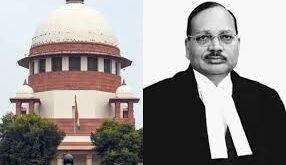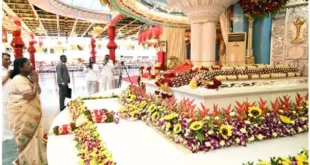Ayodhya, Nov 25 (PMI) – In a historic and spiritually significant moment, Prime Minister Narendra Modi ceremonially hoisted the saffron Dharma Dhwaj atop the Shikhar of the Shri Ram Janmabhoomi Mandir in Ayodhya, marking the completion of the grand temple’s construction. The occasion coincided with Vivah Panchami, celebrating the divine wedding of Lord Ram and Mata Sita. The ceremony witnessed the presence of RSS Sarsanghchalak Mohan Bhagwat, Uttar Pradesh Chief Minister Yogi Adityanath, and several dignitaries and devotees.
Centuries-Old Aspirations Fulfilled
Addressing the gathering, PM Modi described the moment as a historic cultural awakening. He said, “Centuries-old wounds are healing as the long-standing devotion of Ram bhakts spanning five centuries is finally being realised.” He emphasized that this milestone represents both the spiritual fulfillment of devotees and a symbol of India’s timeless devotion and heritage.
Symbolism of the Dharma Dhwaj
The 10-foot-high and 20-foot-long saffron flag features a radiant Sun, the sacred Kovidara tree, and the ‘Om’ symbol, representing Lord Ram’s brilliance, valour, and the glory of Ram Rajya. PM Modi explained that the flag is not just a ceremonial piece but a representation of India’s cultural resurgence, moral responsibility, and ethical values. It embodies collective effort, devotion of saints, and centuries-old aspirations coming to fruition.
Spiritual and Cultural Significance of the Temple Complex
PM Modi highlighted the holistic spiritual experience offered by the temple complex. The Sapt Mandir, Mata Shabari Temple, and Nishadraj Temple symbolize devotion, love, and friendship. Statues of Jatayu and the squirrel reflect how small contributions can lead to great achievements. The complex also houses temples dedicated to revered sages including Maharshi Valmiki, Maharshi Vashishtha, Maharshi Vishwamitra, Maharshi Agastya, Mata Ahilya, and Saint Tulsidas, emphasizing India’s rich spiritual heritage.
Vision for a Developed India
The Prime Minister urged citizens to break free from mental slavery and embrace self-reliance. He said, “Lord Ram resides in every Indian home and in the hearts of every Indian. If we resolve ourselves, we can achieve the dream of a developed India by 2047.” He also underscored India’s democratic spirit and the importance of moving beyond colonial mindsets to achieve progress across all sectors.
Ayodhya: Tradition Meets Modern Development
Highlighting Ayodhya’s transformation, PM Modi said the city is being developed as a model of modern urban planning while preserving its sacred heritage. Since the Pran Pratishtha of the temple, over 45 crore devotees have visited, contributing to the prosperity of the city and surrounding areas. He stressed that the Saryu riverfront and upcoming urban initiatives will create a seamless blend of tradition and modernity.
Timeless Values of Lord Ram
PM Modi reflected on Lord Ram’s teachings, stating that devotion transcends caste, and righteousness, cooperation, and virtue take precedence over lineage, power, or wealth. He emphasized that these timeless values will guide India’s collective progress.
Culmination of a Sacred Yajna
Describing the flag hoisting as the culmination of a 500-year-long sacred yajna, PM Modi said it marked the dawn of a new era of cultural celebration, spiritual awakening, and societal unity. He reaffirmed that Ayodhya is set to become a city of inspiration for the world, blending moral values with modern development.(pressmediaofindia.com)
 Pressmediaofindia
Pressmediaofindia






